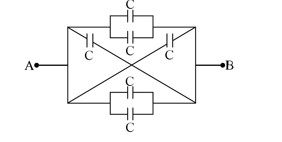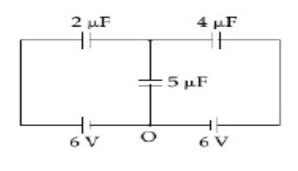Capacitors and Capacitance
Get insights from 4 questions on Capacitors and Capacitance, answered by students, alumni, and experts. You may also ask and answer any question you like about Capacitors and Capacitance
Follow Ask QuestionQuestions
Discussions
Active Users
Followers
New answer posted
2 months agoContributor-Level 10
Now, using junction analysis
We can say, q? + q? + q? = 0
2 (x - 6) + 4 (x - 6) + 5 (x) = 0
x = 36/11, q? = 36 (5)/11 = 180/11
q? = 16.36µC
Related Tags
New answer posted
3 months agoContributor-Level 9
dC? = (ε? + kx)A / dx [For 0 < x < d/2]
1/C? = ∫ dx / (ε? + kx)A) from 0 to d/2
= (1/Ak) [ln (ε? + kx)] from 0 to d/2
= (1/kA) ln (1 + kd/ (2ε? )
C? = kA / ln (1 + kd/ (2ε? )
Similarly dC? = (ε? + k (d-x)A / dx [For d/2 ≤ x ≤ d]
C? = kA / ln (1 + kd/ (2ε? )
Clearly, C? = C? = C
For series combination:
C_eq = C? / (C? + C? ) = C/2 = kA / (2ln (2ε? + kd)/2ε? )
Taking an Exam? Selecting a College?
Get authentic answers from experts, students and alumni that you won't find anywhere else
Sign Up on ShikshaOn Shiksha, get access to
- 65k Colleges
- 1.2k Exams
- 679k Reviews
- 1800k Answers


